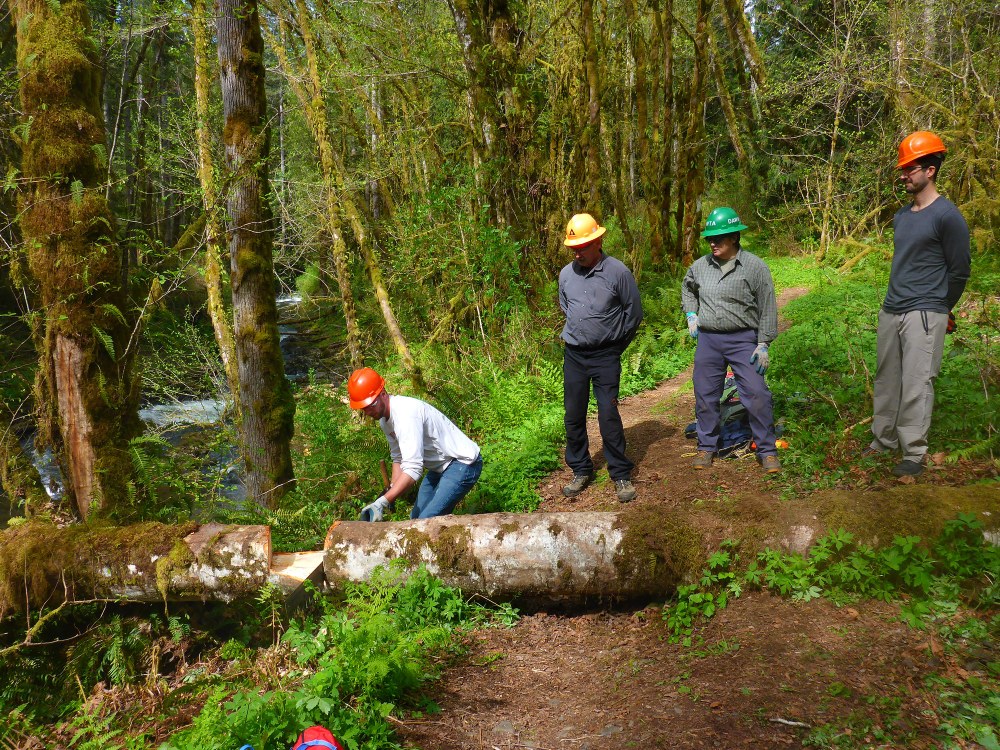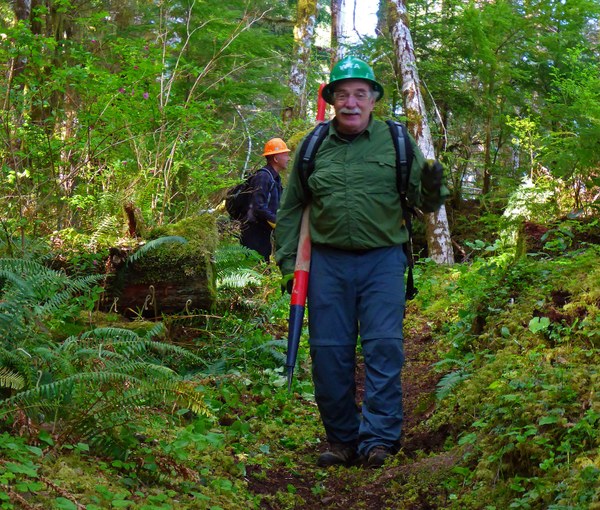
Jim French, a 20-year Mountaineers stewardship trip leader, has noticed a familiar refrain from new participants. After a long day clearing trails, removing invasive species, or seeding native plants, they exclaim, “Wow, that was great! I would have never done that if it hadn’t been required as part of The Mountaineers course I’m taking. I’d like to do it again.”
For those unfamiliar with Mountaineers courses, many of them call for students to complete an eight-hour stewardship day in order to graduate. In The Mountaineers’ world, part of becoming a skilled climber, scrambler, or hiker is practicing good outdoor ethics and giving back to public lands.
Commitment to service is paramount to The Mountaineers’ conservation mission. But as Jim’s crew members learned, there’s more to it than that. Stewardship takes people to beautiful places like Mount Rose, Porter Falls, and the Elwha River, where participants spend the day doing meaningful work alongside fellow outdoors lovers. In short, it’s fun.
Jim thinks of it as the “raisin bran effect.” The service part is like the bran — healthy, nutritious, and rewarding. But it’s the sweet raisins, the joy of being outdoors, that’s the best part.
The tricky part is getting people to give stewardship a try. The course requirement is a big help, but Jim and his fellow leaders at the Olympia Branch began to wonder if they could do more.
This year they issued a challenge: dedicate at least one day to stewarding our public lands. The Olympia Stewardship Challenge is now off and running and the hours are starting to roll in. Mountaineers from all branches are encouraged to join.
From a Committee of One to a Vibrant Community
In 2017, the Olympia Branch led 58 stewardship trips, culminating in about 1,800 volunteer hours. That didn’t happen overnight.
Jim recalls attending his first Olympia Branch Banquet back in 2000. He was new to The Mountaineers. Marilyn Miller, the Branch chair at the time, announced she wanted to get the conservation committee started again and was looking for volunteers. Jim recalls with a chuckle that as the only person who stepped up, he became a committee of one. He began setting up stewardship activities for branch members to join.
“Personally, I’ve always felt compelled to care for the natural world” says Jim, who’s now retired after a long career with the Washington State Parks System. “My hometown is Steubenville, Ohio. It was declared the dirtiest city in America. The place where I grew up was singled out as a health hazard due to pollution from coal burning and steel mills. I thought that it was terrible, and I went on to study conservation in college.” A lifelong passion, Jim figures he spends about 25 hours a week on stewardship-related stuff these days.
 Jim French on the Wynoochee Lakeshore Trail. Photo by Ginger Sarver
Jim French on the Wynoochee Lakeshore Trail. Photo by Ginger Sarver
Jim led almost all of Olympia’s stewardship trips until about five years ago when another Olympia conservation rock star, Kathy Fox, came on board.
Kathy hatched a leadership training plan: they’d ask Olympia members to step up as “Assistant Leaders,” then ease them into increasing responsibilities such as scheduling their own trips and coordinating with land management agencies and other conservation nonprofits.
“Kathy came up with the idea getting more people involved,” says Jim. “And I was so impressed with how they rose up to the challenge.”
Currently, Jim estimates the Olympia Branch has 22 crew leaders who can run trips. Jim and Kathy co-chair the Olympia Conservation & Stewardship Committee, which also has an advisory council. In addition to Jim and Kathy, the council consists of Jack Sisco, Keith Arnold, Ginger Sarver, Jennifer Fortin, and Tony Santolla.
“Jim’s the heart and soul of our committee,” says Ginger Sarver. “His enthusiasm and dedication inspire everyone who is lucky enough to work with him.”
Jim’s noticed that each new leader brings a unique interest to their role, which ushers in an ever-growing list of conservation partners. The Olympia Branch now works with over twenty agencies and organizations, such as Washington Trails Association and Capitol Land Trust.
The Olympia Branch’s list of projects runs the gambit from those you might expect, such as trail maintenance at nearby parks and forests, to those you might not, such as working with MeadowWatch on a citizen science program to study climate change’s effect on Mount Rainier’s alpine flowers, and working with Stream Team to monitor amphibian eggs masses (a good indicator of an area’s environmental health).
When asked if there’s a particular project he’s most proud of, Jim doesn’t have one. “I’m proud of sticking with it,” he says. “And having a group folks that are also sticking with it.”
In the beginning, Jim recalls reaching out to land managers who didn’t know whether his group would come out “for an afternoon to have a picnic” or whether they were committed to public lands for the long haul. Now, the Olympia Mountaineers are known for working on stewardship initiatives throughout the South Puget Sound.
“It took years to demonstrate that we were determined and that we would be of service,” says Jim.
Public Lands Need Our Help
Jim doesn’t hesitate when asked about the biggest challenge our public lands face. “Funding,” he says. “The lack of resources makes things a constant struggle for our land management agencies, so they end up with a huge backlog of maintenance issues. They have trails that are almost unserviceable because they don’t have anybody to work on them.”
On the advocacy side of things, The Mountaineers continues to push for long term funding solutions. “Recently, we were heartened that Congress established a wildfire fund for the Forest Service,” says Katherine Hollis, Mountaineers Conservation & Advocacy Director. “The fund will allow the Forest Service to address wildfire costs without tapping into reserves originally allocated for recreation and conservation projects."
During his spring trip to Washington D.C., Mountaineers CEO Tom Vogl had great conservations with our Washington State lawmakers who champion causes like the Land & Water Conservation Fund and the National Park Service Legacy Act.
Unfortunately, our public lands can’t afford to wait. Our national parks, for example, face a $12 billion maintenance backlog.
“It’s up to volunteers to lend a hand so we can keep our parks, forests, and trails usable,” explains Jim.
Alieving this massive problem comes down to lots of people doing what they can, when they can. It comes down to people like Jim, Kathy, and the Olympia crew stepping up to the challenge, and all of us joining the cause.
This article originally appeared in our summer 2018 issue of Mountaineer magazine. To view the original article in magazine form and read more stories from our publication, click here.
Update on the 2018 Stewardship Challenge
Wondering how the challenge is going? Check out this blog for an update.
Add a comment
Log in to add comments.On National Trails Day, I answered the call this year for my first trail work since Boy Scouts. It was satisfying and a great time. Congratulations to the Olympia Conservation Committee for their work.
 Peter Dunau
Peter Dunau